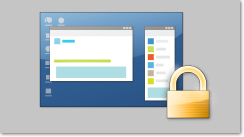 The TrustApp package offers a comfortable, fast and reliable solution for development of highly secured software. Programmers can thus focus to the maximum extent possible on the application functionality development itself.
The TrustApp package offers a comfortable, fast and reliable solution for development of highly secured software. Programmers can thus focus to the maximum extent possible on the application functionality development itself.
-
What is TrustApp?
-
Framework for creation of C++ applications that are highly secured against:
- Unauthorized modification of program code and data
- Extraction of key algorithms and data
- Unauthorized use of an application by means of:
- smart cards / hardware keys (dongles)
- a server, e.g. a licensing system
-
Framework for creation of C++ applications that are highly secured against:
-
For whom is the TrustApp package destined?
- For anyone who wants to develop applications quickly with a high level of security
- For anyone who needs to protect their ideas and algorithms
-
How to use TrustApp?
- After purchasing the TrustApp package, you will obtain a framework of highly secured end-user application and a large number of libraries simplifying the development of secured software.
- You implement your program code directly into the application framework using the supplied security libraries.
Details:
- Implemented secure communication protocols designed for communication with a server
-
Basic obfuscation of
- multilingual string constants (8 bit, 16 bit)
- working data blocks in the memory (Win32 API calls)
- the majority of syntactic constructions
- infrastructure of error reporting and debug statements
-
Secure data storages (Win32)
- Linkage of data with a specific computer
- Linkage of data with a specific user account
- Possible secure storage of authentication data
-
Basic cryptographic algorithms
- Asymmetric cryptography
- Symmetric cryptography
- HMAC
- Zero-Knowledge Proof algorithms
- Various hash algorithms
-
Advanced obfuscation techniques
- Tools for transformation of source code into a form which is extremely difficult to analyze
- Transfer of a part of executable code to a location inaccessible by a potential attacker. The execution shall be conditioned by a previous authorization.
-
Protection against modification of executable code
- Automatic identification of attacks aimed at the executable code
- Digital signature of the embedded bytecode











